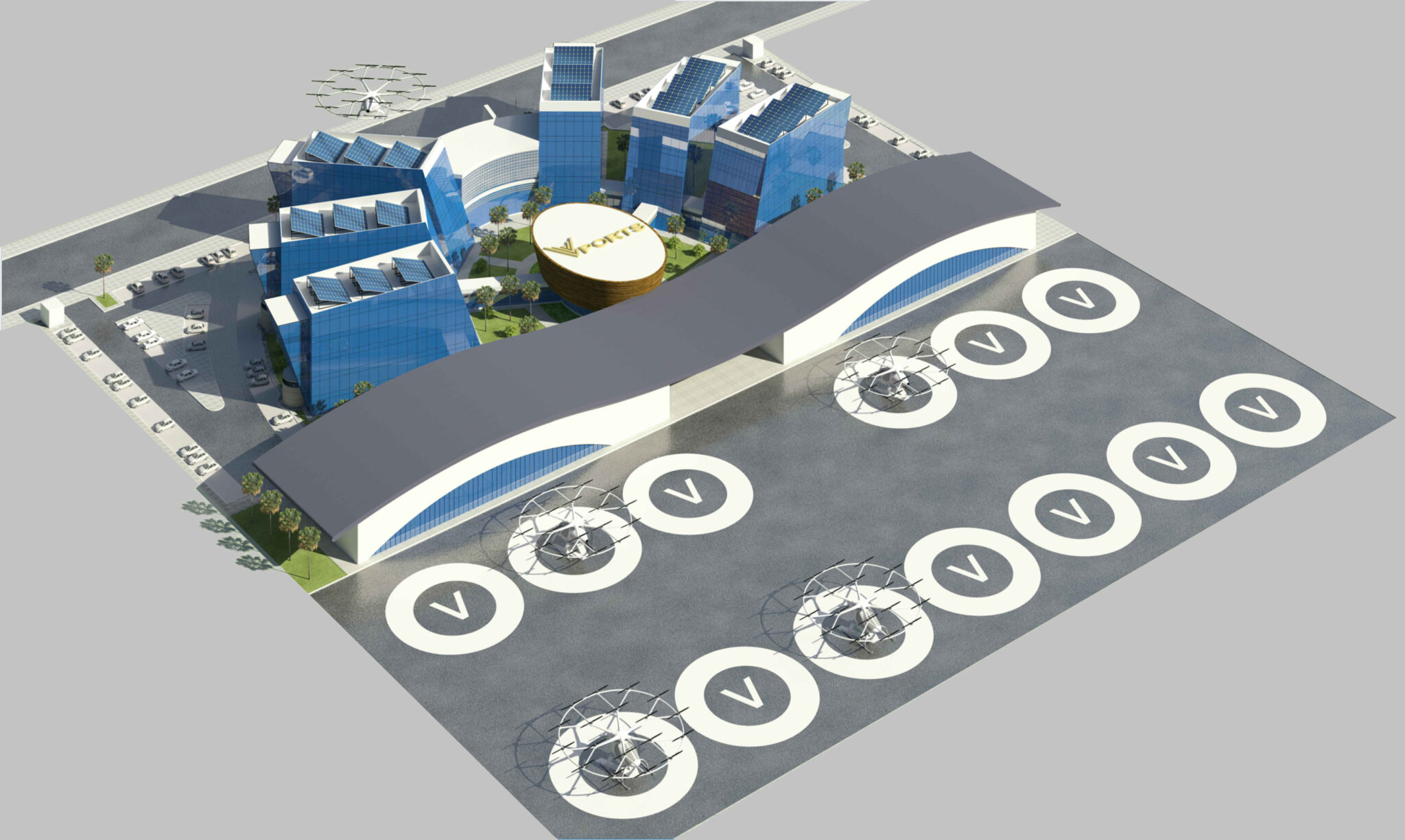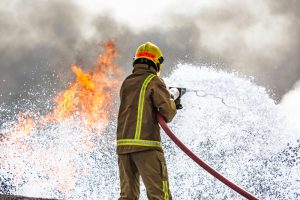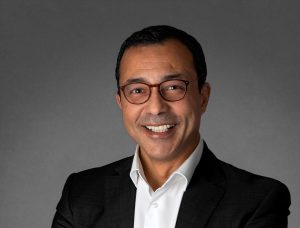
Fethi Chebil is CEO and Founder of Vports. In June this year the company initiated the certification process for its vertiports as part of the world’s first AAM integrator centre at the Mohammed bin Rashid Aerospace Hub (MBRAH) in Dubai South. Construction of the vertiports will start in 2024.
What work is taking place at the AAM integrator centre?
In our Dubai AAM project, the idea is to enable the establishment of an ecosystem where the key players in advanced air mobility can work together around innovation, new technologies and social acceptability; where charging facility operators can test their expertise at the same time as eVTOL operators are flight testing and the regulator is involved in all aspects of enabling the AAM industry in UAE and establishing a vibrant ecosystem there.
At a time when eVTOL manufacturers, air navigation service providers (ANSPs), charging facility companies, vertiports operators, and other players associated in AAM are all working separately on their own projects, the Dubai AAM integrator is bringing them all together in a single eco-system. That is the purpose of the centre, and we have an exclusive lease agreement in Dubai South for 50 years.
When we began our conversations with different stakeholders the need of a digitized airspace where all eVTOLs can operate became clear. In the United Arab Emirates, we are creating this environment in which any eVTOL can fly and we are working with the ANSP DANS and the regulator GCAA to develop an airspace corridor to do exactly that.
Now we need to start building the vertiport and the operations control centre which will integrate and coordinate the flights in and out of our network of vertiports, which includes Dubai south plus the other vertiports we are developing all around the UAE. The UAE is for the moment the only country which has published detailed certification regulation related to vertiport construction, operation and training.
I thought other countries had developed guidance material for vertiport developments?
Other countries have different strategies for introducing regulation. Australia, Europe and the USA, for example, have issued design guidance, for now, and you can use these references to build your vertiport. But if you want it to be certified it’s a different dynamic.
In the USA you can build a private vertiport if you don’t want the FAA to involved. But in the UAE if you have any commercial activity at your vertiport you must be certified.
We are the only ones going through certification process on the infrastructure side because our vertiport is in the UAE. It’s a very interesting process because we have to think about all the range of activities which take place at a vertiport, including fire-fighting responses. For instance, we have to develop the manuals and operating procedures so we can handle any kind of operation at the vertiports.
What we are doing now is paving the way for the next players to engage in this industry; so they can follow the processes that we are developing.
Think about the operational procedures required for ground handling, for example. Other challenges are related to the situations of fire: how to handle an emergency pertaining to a fire in an eVTOL at our vertiport. What type of, and how many, fire trucks are required, if any? How should we coordinate with the manufacturer in an emergency? How should we manage these types of emergency? Should we follow the same process as we are following now in regular aviation industry – typical aircraft, water and foam, fire trucks, number of firefighters, training, etc. – or do we need a new set of rules that would be built based on a different set of references, such as eVTOLs manufacturing materials, type of batteries and so on? We are working out details and we are reaching out to a range of eVTOL manufacturers to make sure we will be compliant.
“We are working with manufacturers to understand their battery charging procedures and the materials they will use in the eVTOL structure, to understand what fire fighting solution will work best “- Image, Shutterstock.
We now have different types of emergencies that we need to address and cybersecurity is one of them. Due to the volume of traffic we will be managing, we believe that the most challenges in case of emergencies will be related to airspace integration and air traffic management.
I don’t think anyone has done this before.
For airports to build a firefighting team they need to know what kind of aircraft will be using the facility and we need to go through the same procedure. I am an ICAO safety expert so these kinds of questions are part of my expertise. We don’t need to be totally innovative but we have to work very closely with the regulators and eVTOL manufacturers so they become comfortable with the ideas we are developing. Yes, we are the first, but my strategy is not to develop something entirely new because that will be very complicated to certify. So we follow the same strategy and framework developed for airports, as a starting point to enable the certification process.
Have you identified how much foam and water you will need to manage an eVTOL fire and specified this in a manual?
We are working with manufacturers to understand their battery charging procedures and the materials they will use in the eVTOL structure, to understand what fire fighting solution will work best. These two elements will be the basis on which we will develop a firefighting strategy. This is completely new. We will need to know this before we think about what combination of water and foam and what type of training our firefighters, if any, will need.
This will have an important impact on our OPEX and CAPEX calculations. How many people will we need? How much will this cost? Where will the equipment come from and how should it be maintained?
We need to see the bigger picture; eVTOL manufacturers are focused on the airworthiness of their vehicles, for vertiport operators the focus is on the operation. At some point we will have to work together to integrate flight testing with the ground handling operation. That’s one of the main objectives of our Integrator Centre in Dubai. The Integrator Centre is to set up a framework and do this kind of discussion and tasting. Regulators have also to take a leading role in this. They can’t wait.
How much of the detailed vertiport operating procedures can be adapted from current commercial aviation regulations and how much is new?
So far, the regulator’s starting point in terms of vertiports is the ICAO Annex 14 volume 2 related to helipads. The key assumption here is that a vertiport is a type of a helipad but the aircraft is different. Based on this assumption, our Vertiports Manuals and Standard Operating Procedures (SOPs) would have the same content as a typical airport Manuals and SOPs: Manuals related to Maintenance, Operations, Emergency, etc.
What is the process for the regulator signing off on the new procedures and operations?
In summary, there are three steps. Step one is design acceptance, where we submit a document to the GCAA, which defines the design, physical characteristics (lighting, markings, etc. of the vertiport). Phase two is another block of documents developed in discussions with the ANSP – how the eVTOLs will fly in and out of the vertiport. The third is the development of a package of manuals and SOPs, showing how we will operate our vertiports. So we have a design team doing the design, an operation team to think about the operation and another team drafting the manual of operations, which includes the emergency response plan.
Once these packages of documents are submitted and accepted by the regulator, then we go to the construction phase with a construction team while working with the ANSP to establish the airspace configuration.
The third part is for the regulator to visit the site and to initiate the certification based on the construction, operational procedures and the airspace integration. They also have to be assured that the people assigned to operate the vertiport are trained.
And this is one of the key questions: airport position holders are qualified to operate because they are trained in an approved school. We need to do the same here: training our position holders in an approved training centre which will be accepted by the regulator to train our people. We hope that within the next two years approved training centres will be available for vertiport operators.
Our plan is by 2027, when we start commercial operations, everyone working within the eco-system will be fully qualified. This is an ecosystem we are building. We cannot do this alone. We need to work with the regulator, the ANSP, the eVTOL operators and manufacturers, the charging system providers, the emergency response teams and the emergency fire rescue industry suppliers. A lot to do ahead of us.
Are you at all concerned that eco-system developers in other parts of the world aren’t addressing the regulatory and operational issues to quite the same extent?
I’m concerned about the lack of understanding of the complexity that vertiport operations will need to address. It’s complex. We have to go through thousands of details.
I believe that stakeholder engagement within counties, or within a group of countries, discussing these operational and regulatory details is crucial and needed now. As the pressure is on eVTOLs airworthness certification for now, other components of the AAM ecosystem are not on the table yet. I think this is a mistake, as the AAM industry won’t be financially viable and no commercial business case will be possible if we don’t address from now a myriad of operational challenges: airspace configuration, firefighting, charging, certification, etc.
But will get there. No regulator on the planet will accept a system in which an eVTOL will fly without thinking about all these details.
There are also non-aviation stakeholders to consider. But how much of what you are doing in Dubai can be used a precedent for operations elsewhere in the world?
The ecosystem’s framework is different from country to country. In some countries there is a legacy of aircraft manufacturing, which is very powerful, but there is a different dynamic within different countries. Having said that, the key components are the same. There is a regulator, an ANSP, an eVTOL manufacturer, a vertiport operator and a charging facilities provider. These are components you have everywhere.
We are internationally located and this really challenging but it is exciting, too, because we can transfer know-how from one area to another but being mindful of the legacy.
For example, we are also working in Montreal and the US, where the dynamic between the players in different. Furthermore, our key business cases worldwide are mostly around regional, cargo and health. We are not on the urban eco-system, yet. So our relationship with cities is different. We are more concerned about airspace and vertiports operations and eVTOLs related technologies. This takes a long time because we have to go city by city, council by council, person by person, to explain the impact of vertiports and why how it would impact them.
In Montreal and New York we are working with Federal and state levels. In San Paulo we are focusing on developing a VIP facility close to the terminal building, creating another way to move from downtown to the airport using a vertiport. In Dubai, our vision is larger: establishing an ecosystem.




